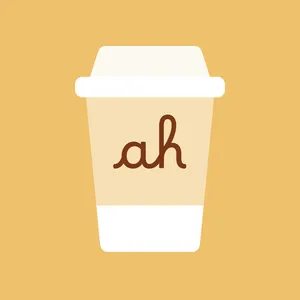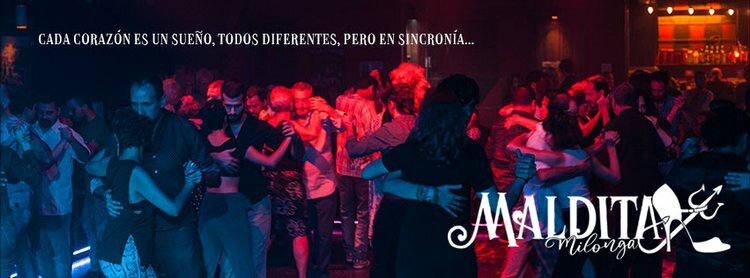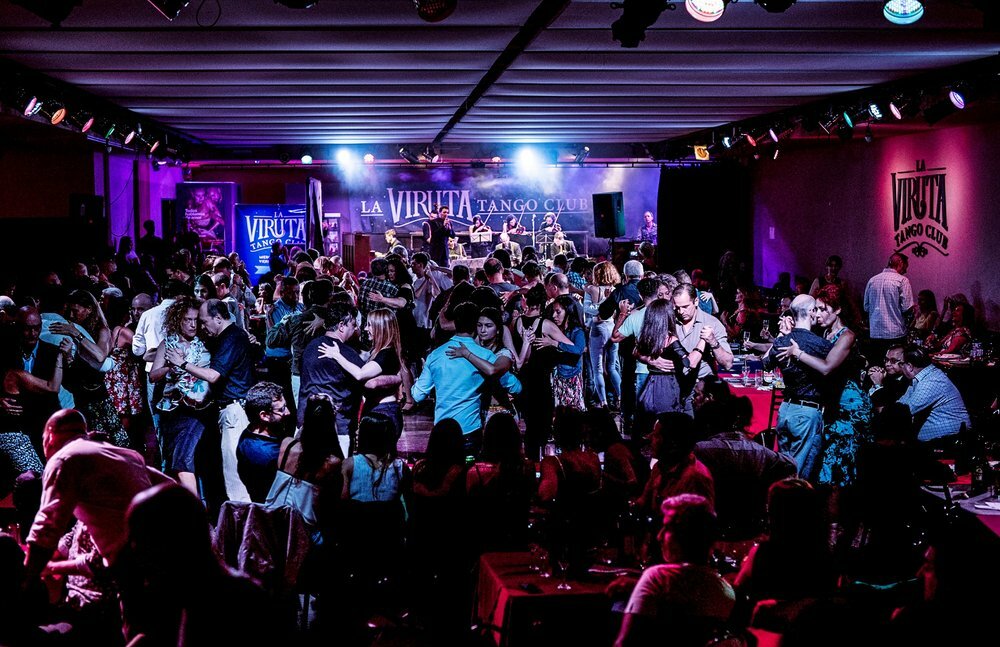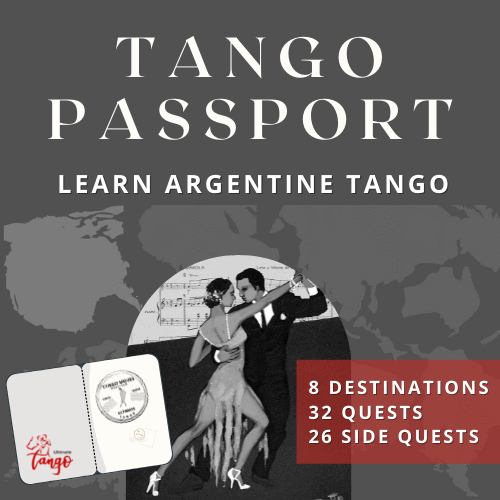If tango is like a stealthy panther, then milonga is its nimble parent.
Tango requires dancers to move slowly and sensually, but sometimes dancers should be sharp, executing staccato movements like a quick foot flick or a head snap.
It takes patience to learn how to move like that. When you discover other tango genres, you realize that there's more to tango than meets the eye.
Getting to know the milonga can be confusing as the term has three meanings: dance, music, and social tango.
The dance shows a faster side of tango. Yes, tango came from an even quicker dance! Think of it this way: you meet some families where the children clearly take after their parents but have their own quirks.
Milonga and tango are the same way; the tango has similar characteristics but is different enough to warrant its own recognition.
Let’s become acquainted with milonga, the origin of tango.
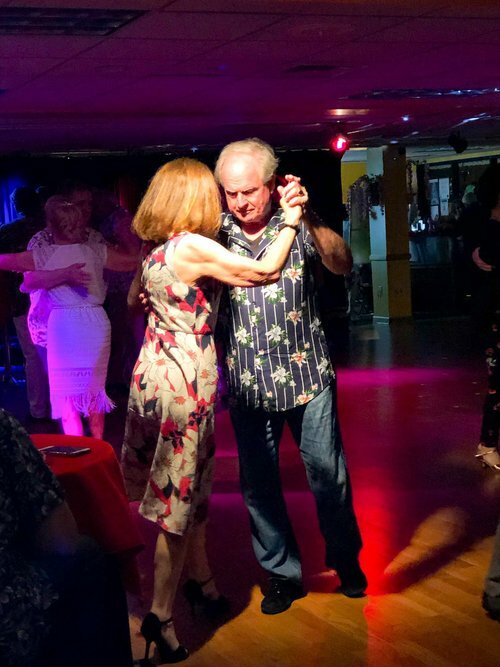
(Milonga as a Social Dance held at Ultimate Tango School of Dance)
Milonga: Music, Social Tango, or Dance?
When you hear the word “milonga,” it could mean one of three things.
Liveaboutdotcom defines Milonga as a type of music, a social tango event, or a dance.
All three milongas have different origins.
Milonga music started in Uruguay and Argentina.
It combines the polka and the Cuban habanera with native Argentine music styles, featuring a singing style called “payada de contrapunto.”
Milonga, the social tango, started in Buenos Aires' lower-class neighborhoods in the late 1800s.
Birthed from the “payada de contrapunto,” the tango party had Argentine cowboys (gauchos) playing the guitars and singing about life.
Finally, milonga as a form of dance started in the early 1900s.
Merriam Webster defines it as an Argentine ballroom dance that preceded the tango early in the 20th century. Milonga is different from vals and tango, which we will get into later. It has steps that are perfect for challenging beginners. It is also excellent for those who want to learn how to move quickly without having to think too much about complicated patterns.
Brief History of Milonga Dance
Milonga started in the 19th century in Buenos Aires, Argentina. Gauchos blended the habanera, the polka, and other global folk dances in local brothels.
Eventually, Argentines danced it everywhere, with composers and singers creating songs by the late 1870s. Those who belonged to the higher classes frowned upon it, considering it a dance that disregarded societal norms.
Pianist Fernando Otero is one of the most famous Argentine milonga music composers. According to Dance Facts,
during the tango's golden age, the music received much attention from other Argentine and Uruguayan artists like Angel D'Agostino, Aníbal Troilo, and Ástor Piazzolla.
As society slowly accepted physical closeness between men and women while dancing, the milonga dance became more prominent in middle-class society. This was also when the milonga developed the Argentine tango, the dance style that is slower, more dramatic, and synchronized.
Now, the milonga remains an essential part of Buenos Aires' cultural identity. It is still a popular dance and music genre that locals and tourists enjoy today.
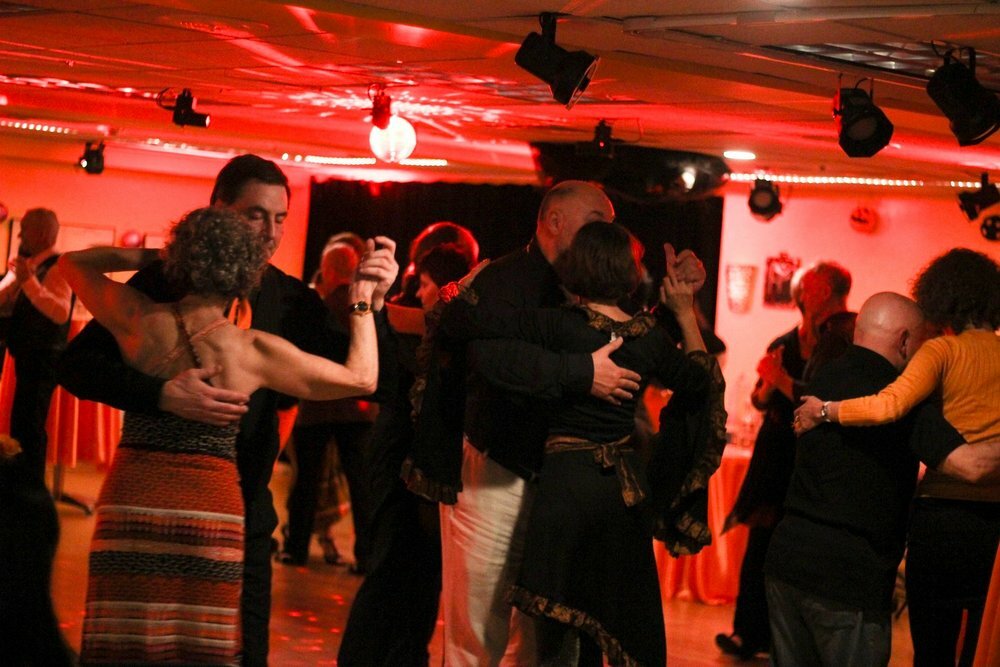
(Milonga at Ultimate Tango)
Dancing to Milonga’s Rhythm
Milonga is a fusion of European and Afro-Caribbean influences, generally relying on physical closeness.
What sets it apart from other dances is its elements of comedy, with dancers doing improvisations, jerks, or exaggerated moves.
The “quebradas” are the movements that convey irony and comedy through exaggerated drama or humorous appearances.
The milonga also features the “cortes,” which are suggestive pauses that signal dancers to suddenly totally stop.
The cortes breaks the dance's flow even in the middle of comedic poses.
Because the milonga is danced to milonga music, it has a rhythm that follows a 2/4 tempo.
With quick movements similar to those of waltz or foxtrot, the milonga is often considered one of the most challenging dances for beginners to learn.
Milonga steps are similar to waltz steps, only quicker. Milonga also has an eight-beat measure, whereas waltz has a three-beat measure.
You can also look at the dance like it's a fast, happy tango done in 2/4 time with exaggerated movements!
Types of Milonga Dance
Milonga has two main styles: Milonga Lisa and Milonga traspié. Milonga Lisa is the classic milonga, and dancers move and step to the music's every beat. Milonga traspié, on the other hand, is more recent and has broken rhythms. MasterClass describes it as a style that requires dancers to transfer their weight from one foot to the other as they make double steps or incorporate moves that involve three steps across two beats.
Milonga Lisa is the classic milonga, and dancers move and step to the music's every beat.
Milonga traspié, on the other hand, is more recent and has broken rhythms.
MasterClass describes it as a style that requires dancers to transfer their weight from one foot to the other as they make double steps or incorporate moves that involve three steps across two beats.
Milonga in Milonga: Popular Milongas
We've already established that the milonga as a dance is fun and lively. Anyone would want to learn it, enjoy the style, and have the best time on the dance floor. If you're wondering what the most famous milongas are and have the social tango in mind, there's a long list of answers from the Culture Trip.
Buenos Aires — a city that's full of tango according to The Real Argentina — is home to the best milongas in the world. In these places, you can connect deeply with the dance, the music, and the culture.
The milonga (the event) influences how you feel the milonga (the music and dance).
Milonga Parakultural at Salon Canning
Parakultural is a renowned tango production company, and they hold epic milongas with orchestras, singers, and live performances.
The Milonga Parakultural at Salon Canning is a longstanding milonga, promising you an unforgettable milonga experience!
Cachirulo
Traditional milonga is what the Cachirulo at El Beso is all about.
You can explore the milonga dance in different ways with different themed events. At Cachirulo, there's always a good time, whether you're watching or dancing the night away. Though it is an experts-only affair, you can use the milonga to get a feel for how milonga is danced and the music played.
Maldita
Beginners can have the time of their lives at Maldita Milonga.
It's a great place to learn and dance in a supportive and friendly environment. What sets Maldita apart from other milongas is El Atronfe, their live orchestra.
They also provide classes before the milonga starts, so you can learn the basic steps and have a go at it with other beginners.
Confitería Ideal
There's absolutely nothing wrong with dancing the milonga in the afternoon.
Confitería Ideal holds its tango sessions at 3:00 PM, giving beginners and experts a chance to participate in the fun even if they're not night owls.
After all, dancing doesn't have to be just a nighttime party! The milonga also gives you a more historical vibe.
La Virtua
If you're down to dance until the sun comes up, La Virtua is the milonga for you.
As Buenos Aires' premier tango after-party, the milonga comes alive at 3:00 AM. When the other milongas have already closed, dancers head to La Virtua for more music, more fun, and of course, more dancing.
You can best learn about the milonga dance when you immerse yourself in the culture and atmosphere of a milonga. Milongas are not just about the dance.
Milongas are not just about the dance. It's also about social gatherings, etiquette, and experience. You can't see the dance's true beauty if you're not in the middle of it.
Because the milonga is challenging in its own way, it often requires more experience to execute the steps correctly. When you come across the dance for the first time, you might feel overwhelmed by its fast pace and multiple steps. There's the need to keep up, know the right moves, and have a good sense of timing. Don't forget the comedy that makes the milonga a dance that's different from the others.
Watching dancers do the milonga helps you understand its difference from the other dances and see how it birthed new Argentine dances that eventually took over the world. Its quickness, sharpness, and lack of axis transfer make it stand out, introducing you to a whole new world of Argentine dancing!
The Difference Between Tango and Milonga
As mentioned before, the milonga is danced at a much faster tempo than tango. This is the key difference between the two dances. Milonga follows a 2/4 tempo, while tango has a 4/4. Milonga is also considered a “happy” dance because of its speedy nature, while tango is often seen as a sensual and romantic dance.
This means that milonga dancers must be quick on their feet to execute the sharp turns and changes in direction. Milonga is a tango genre known for being nimble and quick.
Whereas tango is all about drama and suspense, milonga is lighthearted and fun. It's often compared to a playful cat, darting around the room with ease. Milonga dancers move quickly and smoothly around the dance floor, effortlessly weaving in and out of other couples.
The milonga is often described as “unforgiving” to tango dancers who are used to the slower pace.
Tango has easier moves and gives dancers more freedom to interpret the music. Milonga, on the other hand, has to be perfected. Dancers can't just go with the flow and hide mistakes in slow movements.
You can look at milonga as a carefree parent, who makes sure everyone's having a good time, and see tango as a child, who's trying to carefully perfect their growth.
Milonga-Vals-Tango
Can things get even more exciting? Well, it will be inevitable to hear "Milonga-Vals-Tango" when learning the milonga, and there's no reason to be alarmed. Argentine Tango South East said that milonga, vals, and tango are related to each other, and you can see people dancing them in milongas (the social tango). When you find yourself in a milonga, how do you figure out if it's a milonga, a vals, or a tango that you're supposed to dance?
Imagine you're outside the dance floor and watching people dancing inside. Tango Space helps you quickly tell if it's a milonga, vals, or tango based on the tempo and meter of the music being played as well as the movement of the dancers.
Milonga's steps are quick and sharp, and dancers don't transfer the axis. Vals are soft, and tango is more grounded and slow. If it's cheeky, it's a milonga. If it's joyful and fluid, it's a vals. If it's passionate and romantic, it's tango.
These three dances have their own characteristics, but they're all rooted in Argentine culture and closely related to each other. When you get to know them more individually, you'll start to see the connections and similarities!
Milonga Dance: Tango With Rush and Humor
It's easy to imagine how it feels to dance the milonga. The music is driving and lively, the steps are sharp and quick, and you must be in the moment, or you'll miss a beat. Like its descendant, the tango, the milonga is about letting the music lead you.
The milonga is also a great way to show your sense of humor. Because it's such a lighthearted dance, dancers can use it to poke fun at each other or themselves.
As Tango Adventure's tanguera — Sasha Cagen — said: tango takes you to the depths of your soul, and milonga brings you to a happy place.
“Whereas tango has a lot of drama and passion in the dance, dancing milonga feels a lot more light. You can't think for a moment when you dance a milonga, because the music takes over, and you are moving in unison with your partner at such a fast pace.”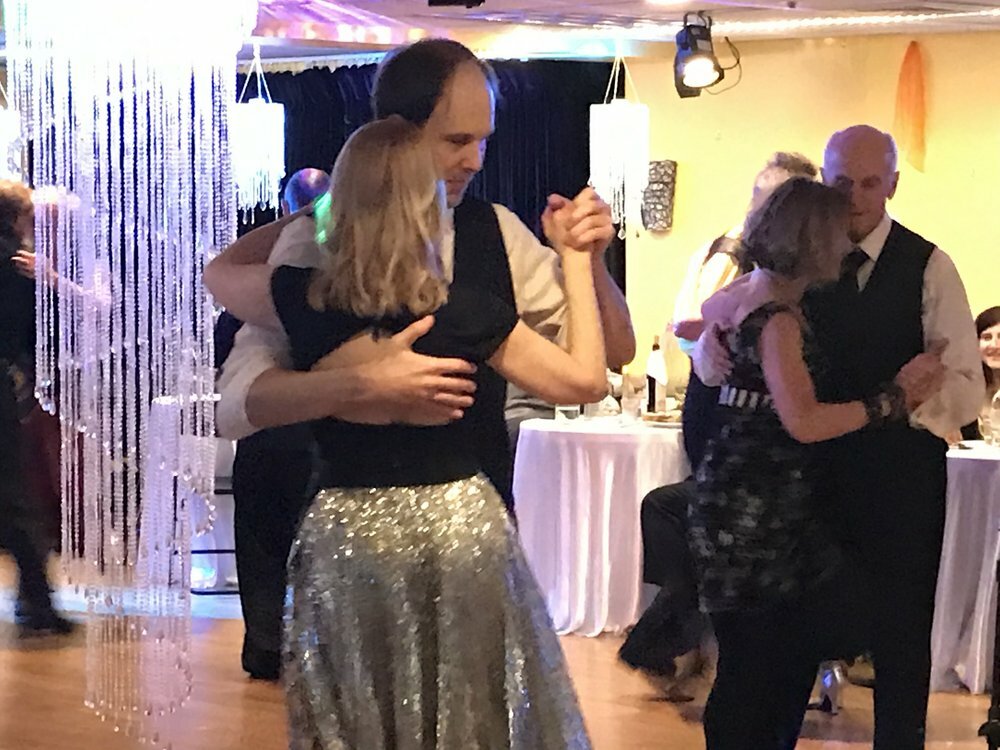
Tango is a passionate and intense dance; the milonga is its carefree origin.
Milonga shares the same DNA as a tango — the music, the embrace, the steps but with more lightness, humor, and playfulness.
At a milonga where people dance the milonga, you'll hear a lot of laughter and see a lot of smiles. The energy is palpable and contagious. If you're not careful, you might find yourself caught up in the moment and swept away by the music.
When you watch dancers do the milonga, you can see how they use the music to their advantage. It has a lot of energy and excitement, which is why dancers use it to show off their skills. They use the fast tempo to incorporate quick footwork and turns.
The milonga carries so much history and culture. It gives you a rush that's hard to find in any other dance. For dancers craving excitement and fun, the milonga is the perfect dance.
It doesn’t matter if you are entirely new to dancing… or have been dancing your whole life. We distill everything you need to know to be able to hit the milonga into simple, easy-to-understand steps. Regardless of your level, this course has something for everyone!
At the end of Tango Passport, you’ll be able to improvise and dance the tango…. anywhere in the world. More details HERE.
